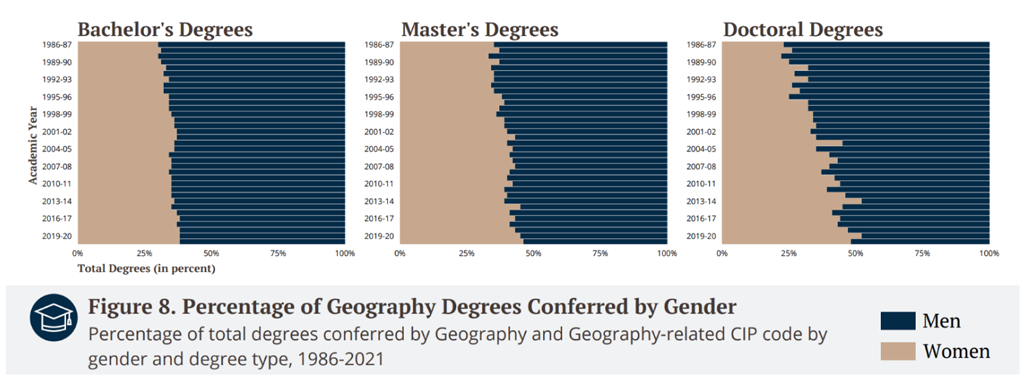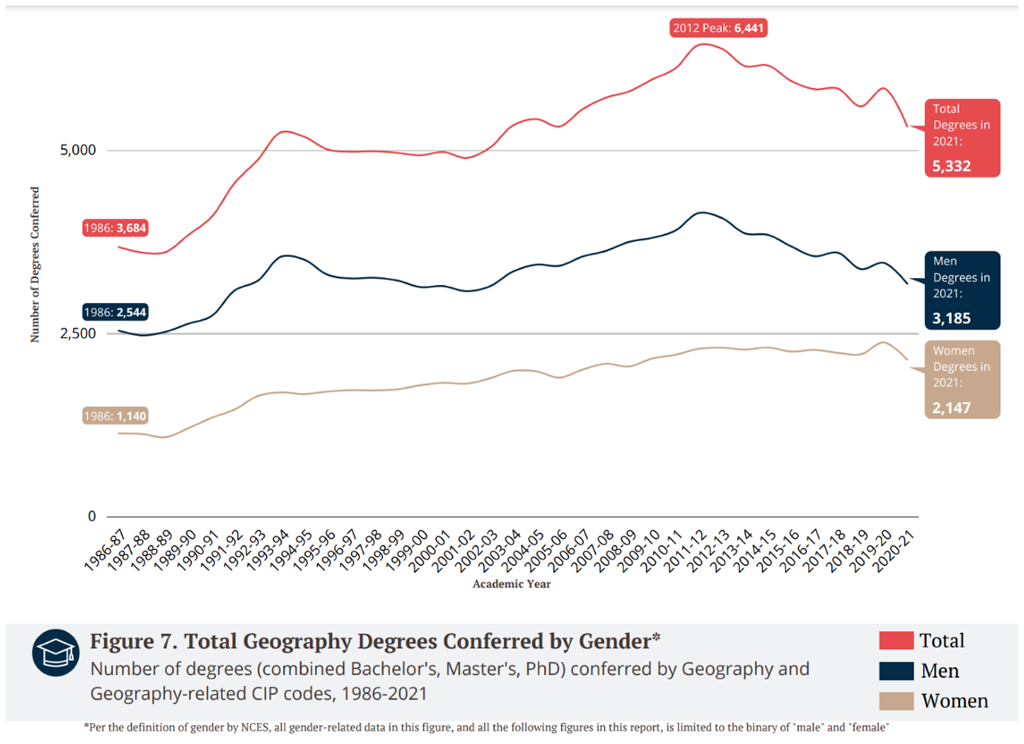The State of Geography: Patterns and Trends by Gender Identity
In December, AAG released the State of Geography report, which provides an overview of broad trends in degree conferral at the undergraduate and graduate levels, both within geography and in comparison with general trends in other social sciences and in academia overall. For the next several months, we—the authors of this AAG report–will examine how these trends manifest, with similarities and differences, among students of differing gender identities, as well as those in racialized categories of identity who have been historically excluded from geography.
The National Center for Education Statistics (NCES) data for Classification of Instructional Programs (CIP) codes form the basis of the State of Geography report. Simply looking at these data, shows immediately how conclusions and even the formulation of questions are constrained by the limits and assumptions in how data are framed and collected. While acknowledging the ways in which the data themselves can shape expectations, we use the information from NCES both to examine the status quo and to push further into new avenues for change and for strengthening the discipline’s equity and representation.
CIP data about gender is based on only the two normative choices: male and female. These categories effectively erase the presence of the transgender and nonbinary people who are pursuing geography degrees. AAG’s own data-gathering, based on voluntary identification of gender by our members, demonstrates that at least 2% of our members identify outside the normative binary. Because the two conventional classifications of gender are so rigid, people who identify differently from “man” or “woman” have to be miscategorized to be counted, their gender identities erased by design. As AAG uses these terms in the absence of better options, we acknowledge the flaw in the data and the need to push the field to more accurately capture the range of genders in future reports.
Still a Man’s Field, But Promising Indicators of Change
The bottom line is that geography remains a male-centered field. However, NCES data and other sources indicate that while people identified as women are underrepresented in total geography degrees conferred, they have more consistent positive growth in degree conferral than people identified as men. The higher representation of women in geography graduate programs than in undergraduate programs could indicate that many women (and any nonbinary people classified in the data as women) find their paths to geography after earning their bachelor’s degrees in other fields. They also appear to have a higher representation in doctorate programs, where the data categories of men and women have reached close to 50:50 parity, and on two occasions students identified as women have achieved 52%.

This proportional change is partly due to a decline in degrees for those identified as men, and partly due to a growth in degrees among students identified as women. The 2012 inflection point, possibly related to the Great Recession that began in 2008, is visible in Figure 7. The pronounced decline in geography degrees during 2012 was not as severe for degree-holders identified as women, compared with those identified as men.

How Geography Compares with Peer Disciplines
Gender proportions for bachelor’s and master’s degrees in geography remain relatively stable in their make-up since 1986, even though other social science degrees at these levels have diversified more visibly by gender during the past several decades. The pattern of higher attainment of doctoral degrees by students identified as women is similar in all social sciences and geography.
In the physical sciences, the gender mix is also showing signs of being more inclusive of people identified as women, this time at all levels from undergraduate through doctorate. Studies in natural resources and conservation in particular show a larger participation of students identified as women relative to other physical sciences related to environmental studies and to geography.
Studies in natural resources and conservation in particular show a larger participation of women relative to other physical sciences related to environmental studies, and to geography.
Overall, although there are positive developments in gender equity within geography, especially at the doctoral level, it still lags behind sibling disciplines such as meteorology, geology and earth sciences, natural resources and conservation, and anthropology in attracting more gender-diverse pool of candidates.
Success Is Not Only in Numbers
The data available to us add to our understanding of the state of gender diversity in geography and academia from 1986 until now. How can we gain further insight, not only into changes in the gender representation in our discipline, but the factors that lead to greater success in diversity and inclusiveness?
An important research goal is to better meet the reality of gender in data collection and studies. Major institutions must transform their data efforts to better include the full spectrum of gender, and they must hear from their research communities to demand this transformation. For example, AAG recently signed on to a joint letter to the National Science Foundation to hold it accountable to previous promises for data collection efforts for sexual orientation and gender diversity. In terms of attainment goals, while it is tempting to let success rest with a desirable ratio, such as the number of degree conferrals, it is better to see such a number as potentially encouraging and a cue to strive further with programming and approaches that promote greater gender representation across the entire career spectrum, including greater support for and access to tenure-track and leadership opportunities.
Numbers alone are not the issue; they are only the indicators of issues, but they are an important starting point. AAG is looking at ways that we can bring about greater quantitative knowledge of the full spectrum of gender diversity in geography. We also know that there are important qualitative considerations underlying the trends we see in geography. For example, we know that the experience of pursuing a degree can be very different across genders. Faculty representation and experience is both an important part of this and its own area worth examining. The work of Brinegar (2001) indicates that gender representation of both faculty and students matters to successful outcomes. Beyond representation, we need to better document how women, trans, nonbinary, and gender-nonconforming people are either empowered and supported or frustrated and discouraged as members of departments, as teachers, mentors, and colleagues.
Experiences in the classroom set the tone: Kinkaid and Fritszche (2022) analyzed 32 class syllabi for graduate-level Introduction to geography classes for the prevalence of many influencing narratives and assumptions, including those related to gender. The researchers found that “seemingly minor decisions about framing, content, and organization” led to reaffirmation of exclusionary ideas about geography, but with some examination and reframing, can also lead “toward more inclusive and diverse imaginaries of the geographic tradition.”
The role of care and support in the academy and professional societies has been studied by Peake and England (2020), Mullings, Parizeau and many others, including the gendered aspects of mental health and wellbeing. Support for mental health and wellbeing, in turn, has a direct impact on the success of geographers of all genders. Career-related questions that additional data could address include: What are the career prospects for geography graduates of all genders, within and outside of academia, in the private sector, and in government? What do we know about pay parity and advancement opportunities? Are goals for gender equity being developed with intersectional experiences in mind, with attention to the experience students and faculty who are Black, Indigenous, and People of Color (BIPOC), who or different nationalities and citizenships, and with access and accommodations for disabilities, to name only a few considerations?
Early trends are also of interest. Data exist from gender trends in AP Human Geography class enrollment in high school, where it seems likely that more people identified as female than male are signing up. Could this open the door wider for undergraduate choices of major? Especially intriguing in this regard is the deepening trend among those identified as women—and we might discover if we collected more detailed data, people of diverse gender identities—to study and contribute to the study of natural resources, climate, and conservation, food security, critical studies, and the like. Is there enough awareness and incentive for these studies to be pursued through geography?
Thinking creatively about how to address these questions through data will take a collaborative effort from all of us. In 2023 and beyond, AAG looks forward to working with our members and geography departments to enhance our understanding of and take action on these questions.
Next month, AAG’s State of Geography series continues with articles on categories of race and ethnicity, as well as data needs.
Get Involved in the Next State of Geography Report:
We look forward to further expanding on our findings in the State of Geography Report in the future, with data from a variety of sources, including NCES, AAG surveys, and AAG member expertise. We welcome questions, ideas, or suggestions about the findings at data@aag.org.
Read the full reportFurther Reading
Peake, L.J. & England, Kim (2020). (What Geographers Should Know About) The State of U.S. and Canadian Academic Professional Associations’ Engagement with Mental Health Practices and Policies, The Professional Geographer, 72:1, 37-53, DOI: 10.1080/00330124.2019.1611455
Brinegar, S.J. (2001). Female Representation in the Discipline of Geography, Journal of Geography in Higher Education, 25:3, 311-320, DOI: 10.1080/03098260120084395
Kinkaid, E. & Fritzsche, L. (2022). The Stories We Tell: Challenging Exclusionary Histories of Geography in U.S. Graduate Curriculum, Annals of the American Association of Geographers, 112:8, 2469-2485, DOI: 10.1080/24694452.2022.2072805

